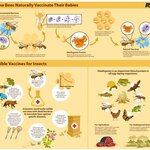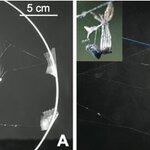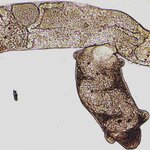Ecology & Zoology

Examination of fossil fragments from Panama has led Smithsonian scientists and colleagues to the discovery of a new genus and species of river dolphin that has been long extinct. The team named it Isthminia panamensis. The specimen not only revealed a new species to science, but also shed new light onto the evolution of today's freshwater river dolphin species.
The fossil, which dates from 5.8-6.1 million years ago, was found on the Caribbean coast near the town of Piña, Panama. It consists of half a skull, lower jaw with an almost entire set of conical teeth, right shoulder blade and two…

In the attempt to choose a mate, it's no surprise that females will select the more "attractive" of two males, but now a new study reveals that female túngara frogs are susceptible to the "decoy" effect, where the introduction of a third, inferior mate results in the female choosing the less attractive of the first two options.
The results of this study counter the rational choice models that are currently used in sexual selection theory, suggesting they may prove inadequate to explain decisions in socially complex and dynamic mating arenas.
To detect the occurrence of the decoy effect in…

In a dramatic 2013 cover story, Time warned of “A World Without Bees,” subtitled “The price we’ll pay if we don’t figure out what’s killing the honeybee.” Its author argued that the class of agricultural pesticides know as neonicotinoids was killing the honeybee and that the planet would starve unless we banned these chemicals immediately. He said this because “1 in every 3 mouthfuls you’ll eat today,” depends on bee pollination. In short: no bees, no food.
The GLP examined that one-in-three myth in a previous article. It documents that soon after the Time article appeared,…

If an unidentified flying object suddenly appeared in the sky, it's likely your heart would beat faster.
Now, researchers have found that the same is true for bears.
The UFOs in this case are actually unmanned aerial vehicles (UAVs), which have become increasingly valuable to wildlife researchers, allowing them to observe animals, including endangered species, in their natural settings from long distances and over difficult terrain. It had appeared as though the animals were taking these encounters in stride. For instance, American black bears rarely seem to startle or run away when a UAV…

For more than a century, researchers have tried to pin down exactly why so many animal species play in their infancy. Now a new study in wild macaque monkeys has found that infants who play more actually boost key motor skills. However, these skills are acquired at a cost. The researchers also discovered that active infants grow more slowly.
So what are the evolutionary reasons behind this trade-off? And should human parents who want tall children sit them in front of the TV rather than letting them play in the garden?
A brief history of play
Play is extremely common in the animal kingdom,…

Will the planet starve if bees disappear? Aren’t bees responsible for a significant chunk of the world’s food supply and nutrition, from one third to as much as 90 percent, depending on what advocacy group is making the claim? You hear such assertions invoked by advocacy groups, reported as truth by journalists and cited by politicians as accepted wisdom whenever the subject of pollinators comes up.
“Seventy out of the top 100 human food crops — which supply about 90 percent of the world’s nutrition — are pollinated by bees,” writes Greenpeace USA on its ‘save the bees’ fundraising campaign…

When it comes to vaccinating their babies, bees don't have a choice -- they naturally immunize their offspring against specific diseases found in their environments. And now for the first time, scientists have discovered how they do it.
Researchers from Arizona State University, University of Helsinki, University of Jyväskylä and Norwegian University of Life Sciences made the discovery after studying a bee blood protein called vitellogenin. The scientists found that this protein plays a critical, but previously unknown role in providing bee babies protection against disease.
"The process by…

People associate wasps with memories of picnic invasions, BBQs under siege, and painful stings. There is a lot more to these much-maligned insects though, and with more than 100,000 different species, their life histories range from the quietly unobtrusive to the bizarre and gruesome. A new study in the Journal of Experimental Biology documents one such disturbing example of wasp larvae that takes control of their unfortunate spider hosts.
The Japanese scientists behind the study thought the host-parasite relationship between the wasp Reclinervellus nielseni (most wasps have only a scientific…

The odds of being attacked and castrated by a variety of parasitic flatworms increases for marine horn snails the farther they are found from the tropics. A Smithsonian-led research team discovered this exception to an otherwise globally observed pattern--usually biodiversity is greatest in the tropics and decreases toward the poles.
The study makes a case for using host-parasite relationships as a tool to understand why there are typically more species--and more interactions between species--in the tropics than anywhere else in the world.
"Unlike free-living species, parasites must use…

We know that Greenpeace and other activist groups really,really care about bees. Really. Not only do they organize petition drives to gather signatures demanding bans on “bee killing” pesticides, they also regularly hold bee “die ins” where they dress up in bee costumes and lie on the ground to be sprayed by faux pesticides.Concerned onlookers hold banners imploring the world to mend its heartless ways and “Give bees a chance” (sing it to the tune of any John Lennon song.)
In 2013, about 200 such activists gathered for a solemn funeral for 50,000 bumblebees (basically one full hive) that…